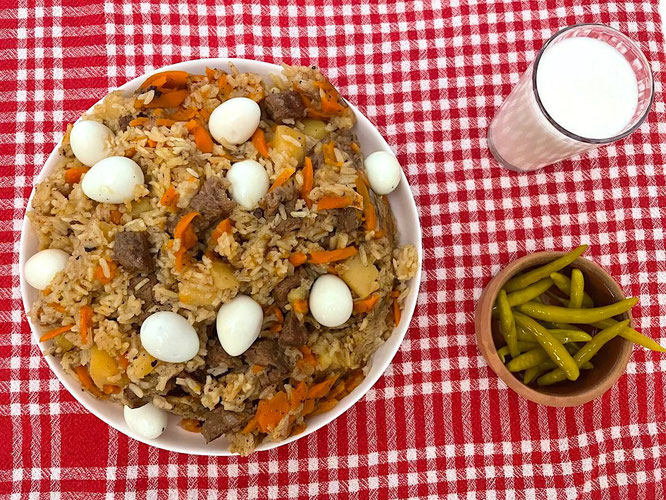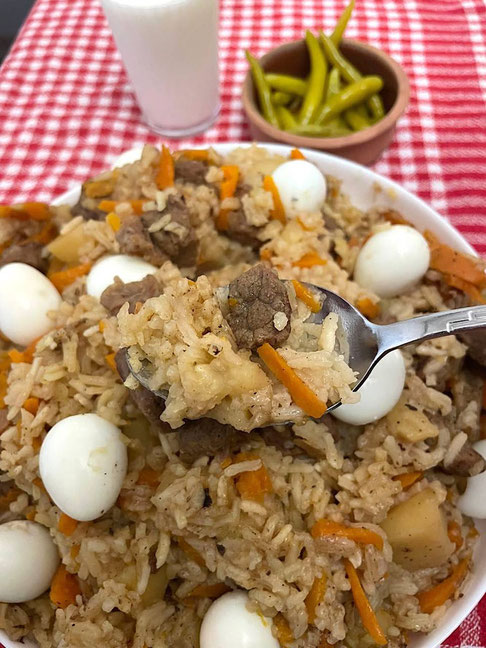
Today we're sharing one of our very favorite recipes: Özbek Pilavi aka Plov! I was introduced to plov by my Chechen friend (the same friend who introduced me to Gilnis), whose mother-in-law always prepared plov in a pot over a fire in the garden. According to my friend, plov had to be accompanied by pickled green tomatoes. Today, we make our plov recipe a little differently than we originally learned. We were mainly inspired by our plov experiences in Turkey. But what is plov anyway and what does it have to do with Özbek pilavi?

What is Plov?
Our food blog is actually all about Turkish cuisine. But of course this is also subject to change and there are all kinds of influences from outside. This also applies to plov (also: plov, bloff, blov). Plov is actually an original Uzbek rice dish with meat, carrots, onions and garlic. These ingredients form the basis for plov. In Turkey, plov is increasingly becoming a trendy dish, which is called Özbek Pilavi, or Uzbek rice dish.
At the same time, there are many Uzbeks in Turkey, even up to the 2nd generation, who are, however, quite "turkified". But of course the plov remains. :-)
What goes into the plov recipe?
The basis for the plov recipe is rice, onions, carrots, meat and garlic. As a rule, large cubes of lamb should be used. However, we have used beef for our plov recipe and you can also make it with chicken as an alternative.
So plov actually sounds pretty unspectacular - but it's a real flavor bomb! Why? There are a few tricks that make ozbek pilavi the ultimate rice dish, the national dish of Uzbekistan, a trend food in Turkey, soul food throughout the Caucasus, Central Asia and Russia and a traditional wedding dish. This includes:
- LOTS of onions: not chopped, but cut into thin half rings
- Carrot sticks: never grate them; it's worth the work!
- at least 1 WHOLE head of garlic: cooked as such in the stock
- plenty of fat: traditionally, the fat is supposed to run down the arm. According to an Uzbek lady I spoke to on a Turkish recipe site, the plov recipe in Uzbekistan is traditionally prepared with cotton oil. You can save a little or a lot of oil and we have also tried to find a balance between original and not too hearty. In some original plov recipes you will even find 200-500 ml of oil. Butter is unusual, but a tasty alternative. Fatsheep tail fat gives the plov even more flavor.
- Cumin: If you want original plov like in Uzbekistan, cumin seeds* must be added to the recipe. They are simply cooked with it. We never have any at home and leave them out of our plov recipe. Özbek pilavi, which is a trend among Turks, can also be made without cumin seeds. However, we have tried plov from an Uzbek restaurant in Istanbul with cumin seeds and it is really delicious. It doesn't come close to the same taste, but we do add a little ground cumin. Regardless of this, plov is very simply seasoned, i.e. salt and pepper.
- Pre-cook the broth: first a kind of soup/broth is cooked and the rice is only added to the broth afterwards. This is how the plov is cooked.

More extras in the plov recipe
You have now learned the basics for a good plov. However, there are a few additions that will enhance your plov experience.
In Uzbek restaurants, plov is often cooked with raisins and chickpeas and served with hard quail eggs*. If plov is used as a wedding dish in Uzbekistan, it is also usually cooked with raisins and chickpeas, so you can tell that someone has got married. Afterwards, the plov is distributed in the neighborhood.
We have left out the raisins and chickpeas, but we like to cook the quail eggs with it. We can find quail eggs in even the smallest discount store in Turkey and they add more fun to the plov. Sometimes in Uzbekistan, chicken eggs are simply fried and served on top of the plov.
You can also add other ingredients to our plov recipe. We almost always add potatoes in large cubes. You can also add a green bell pepper for cooking, which adds more flavor. Some people add turmeric to the plov recipe. In short, ozbek pilavi is an incredibly tasty rice dish that you can spice up in many different ways.

Fun fact: For a long time, we prepared our plov with...fish. Not very fishy, white fish fillet harmonizes perfectly with the other ingredients. Instead of meat, of course.
Tips for the perfect plov
The perfect plov is an art. If you make it wrong, you'll soon have rice with carrots and meat. But that's not what we want, no. We want plov.
To make the perfect, aromatic and not soggy plov, you need to pay attention to a few things. It should be said that enough oil helps in every respect. But to be honest, you can also prepare plov well with little oil.
It is important that the meat - unless you are using very tender lamb - is fairly cooked before the rice is added. Once the meat and rice are in the pot together, there's no going back. In the worst case scenario, you will end up with hard meat in the plov. To prevent this, fry the meat well in advance and boil the stock thoroughly.
At the same time, the onions should be cut really large but thin (rings) and browned. The better the onions are fried to the perfect point, the better the plov will look.
Another really important step is to make sure that you don't mix the plov until the end. The meat, carrots, garlic and other ingredients are cooked in plenty of water and the rice is poured into the stock without mixing. Once the plov is cooked, you should leave it to stand for at least another 15 minutes, but preferably for an hour or even longer with the lid closed. This is also the most important tip for classic Turkish rice. Only when you want to serve the plov should you mix it. You can either mix it in the pot or turn the whole plov out onto a serving tray.
What if the rice is not done? That's not so bad. If the water has evaporated but the rice is still hard, you can add a little more water and finish cooking the plov with the lid closed.
Preparing the garlic for the plov recipe
One of the most important factors for the exceptionally good taste of plov is the garlic. In a simple pot for 3-6 portions, one large or two small heads of garlic are sufficient. Heads, not cloves!
You have to peel the garlic head down to the thinnest skin. We do this by cutting off the tip of the head (where the cloves end) with a knife. The skin can now be easily removed. Then wash the garlic and cut the hairs shorter if necessary. However, make sure that no cloves come off the garlic and that you leave a nice big, intact head of garlic in the plov.
You can also eat the garlic at the end. It is particularly tasty if you press on the garlic head in the finished plov and squeeze out the cloves. You can then remove the squeezed garlic head and spread the garlic puree in the plov.

Preparing the carrots for the plov recipe
Repeat: Never grate the carrots for the plov! This changes the entire taste experience. Instead, cut the carrots into sticks and shorten them to 2-5 cm/1-2 inch each. Incidentally, it's easiest if you chop the onions, carrots, garlic and, if necessary, potatoes in advance and just dice everything beforehand for the plov.
Which rice is suitable for the plov recipe?
Basmati rice is normally used for plov. However, we have added jasmine rice to the plov and we have also often made it with normal round grain (commonly known in Turkey as "Baldo Pirinc") or long-grain rice.
How do you serve our plov recipe?
Pickled vegetables, salad and ayran go particularly well with plov. It can also be served with a few sliced cucumbers and tomatoes.
And here we have to come out of the closet: We love sriracha sauce. Plov+Sriracha=❤️
By the way: We recently prepared Enginarli Pilav, a Turkish rice dish with artichokes. It almost reminded us of plov and might be a vegetarian alternative for you.
Tell us in the comments whether you liked the plov! Afiyet olsun!

Özbek Pilavi: Uzbek plov recipe
Ingredients for 3-5 portions
- 350 grams/12,5 oz of beef or lamb (large cubes)
- 2 carrots
- 1 very large (2 small) onions
- 3 medium sized potatoes
- 350 g rice (2 cups á 200 ml)
- at least 50 ml or 1/4 cup oil (e.g. sunflower oil)
- 1 whole head of garlic
- a little ground cumin
- salt and pepper
You can also use more carrots, more meat and, above all, much more oil. Potatoes can be omitted.
Optional for serving:
- hard-boiled quail eggs
Preparation
Step 1: Halve the onions and cut them into thin rings. Meanwhile, fry the meat well on all sides in the oil. Allow this step to take up to 10 minutes until the meat is browned.
Step 2: Now add the onions to the meat. Fry them over medium heat until translucent or even allow them to brown.
Step 3: Peel the carrots and cut them into sticks. 3-5 cm/1-2 inch long is good. Peel the potatoes and cut them into large cubes. Add the carrots to the pot and mix everything together-
Step 4: Once the carrots are steamed, add the potatoes to the pot. Mix everything together.
Step 5: Pour enough water into the pan to cover all the ingredients by a good 2 cm/1 inch. Season well with salt and add plenty of pepper and a little cumin to the pot. Peel a head of garlic down to the last layer, wash it and throw it into the water. Now bring the stock to boil and cook for about 30 minutes. You can do the same in a pressure cooker.
Step 6: After 30 minutes, the meat should be soft. If it is still too hard, cook it some more. Once the meat is soft, add the rice to the pot. Poke several holes in it with the back of a wooden spoon. If there is not enough water in the pot, add enough hot water to lightly cover the rice.
Step 7: Close the lid and leave the plov to cook over a low-medium heat. If there is no visible water left in the pot, close the stove and leave the plov to finish on the stove for at least 20 minutes with the lid closed. Do not open the lid or stir. The longer you let the plov wait, the better it will be.
Step 8: Only when the plov is completely cooked can you mix it. Originally, the entire pot is turned onto a large serving tray. Serve with optional hard-boiled quail eggs.

Write a comment